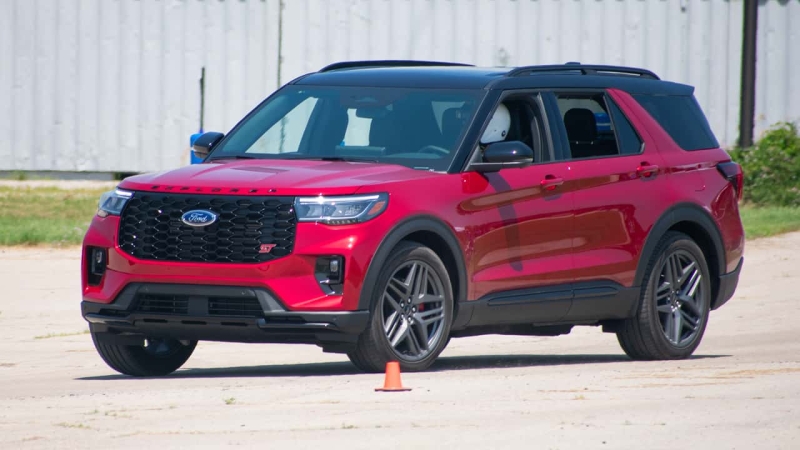It has gobs of new tech, and the ST is amusing. But it feels like Ford is doing too much.
Motor1.com
Here I am, kind of enjoying myself in a 2025 Ford Explorer ST, tires howling as I haul the 400-horsepower, 4,700-pound SUV through an autocross. Thank goodness I don’t have kids. They’d puke constantly if I bought one of these.
An autocross was the third and final stop during a day dedicated to the refreshed Explorer. It started around 8:30 AM in the woods west of Ann Arbor, MI, literally slinging mud on a short off-road course in an Explorer Active. This is the new entry-level model, one of just four in a significantly truncated lineup that nixes familiar badges such as King Ranch and XLT.
| Quick Specs | 2025 Ford Explorer |
| Engine |
Turbo 2.3-Liter I-4 / Twin-Turbo 3.0-liter V-6 |
| Output |
300 HP / 310 LB-FT; 400 HP / 415 LB-FT |
| Base Price / As-Tested | $41,350 / $57,100 |
| On Sale Date | Now |
That’s worth a moment of silence, considering XLT has been with Explorer since the very beginning—1991 to be exact. We’re talking over 30 years of brand equity sent out to pasture.
A Ford representative told me the company wanted to consolidate SUV trims, though the Escape is currently the only other model offered with an Active trim. However, you can get ST-Line and Platinum on other models, and those, along with the performance-tuned ST, now encompass the entirety of the 2025 Explorer range.
Regardless of the name, if you liked how the previous Explorer drove, you’ll like this one too. The powertrain is unchanged for 2025, which means a standard-issue turbocharged 2.3-liter EcoBoost four-cylinder making 300 horsepower and 310 pound-feet of torque. Power still routes to the ground through a 10-speed automatic, and if you jump to the ST, you’ll get the 400-hp twin-turbocharged 3.0-liter V-6. You can also get it as an option on the Explorer Platinum if you don’t want the full-fat ST experience.
What is new, aside from the bigger grille and redesigned front end, is a 13.2-inch touchscreen that Ford Explorer Chief Interior Designer Dustin Shedlarski likened to sitting at home watching a big-screen television. It’s the literal centerpiece of Ford’s new Digital Experience system, incorporating a gaggle of tech that, in theory, is designed to replace your smartphone when you’re on the road.
Ford’s Digital Experience comes with a plethora of apps, everything from Alexa to YouTube, games, an internet browser, and if you’re late for that quarterly video conference meeting, you can attend from the front seat. Google Assistant will help you sort through it all, and yes, you can still connect your phone for Apple CarPlay or Android Auto.
Unfortunately, the Digital Experience also extends to basic climate control functions, which are now relegated to the big touchscreen. Fan speed and temperature settings are easy to get to, but without any tactile sensations, simply adjusting the fan means taking your eyes off the road. If (like me) you wear thin gloves when winter sets in, I imagine this most basic process gets even harder. The complexity isn’t overwhelming but it will take time for owners to absorb it all.
While I didn’t spend a ton of time using the Digital Experience, I did hammer down a busy stretch of I-94 with Ford’s updated BlueCruise 1.2. The hands-free tech makes its debut on the Explorer for ST-Line, Platinum, and ST trims. This version adds automatic lane-change capability, and for my brief time behind the wheel, moving between lanes was as smooth as can be. But you’ll pay for it—BlueCruise 1.2 is a subscription service that costs $700 per year. Monthly subscriptions are also available, though Ford doesn’t have pricing for that just yet.
Swapping the Active for an ST, I literally went to Hell (Hell, Michigan is a real place) on twisty backroads not far from where I grew up. Ford says this is the fastest SUV under $60,000, though you’ll need to forego four-wheel drive to do it. This is where I start to ponder whether Ford really wants the Explorer to be an SUV. The ST is a bit on the firm side, and it doesn’t mind pulling some Gs in corners. There’s just enough fizz to make a normal drive a little less normal, but nothing that makes me want to take the long way home.
And there’s no way you’re enjoying the ST’s performance with anyone in the back. The Explorer’s third row has 32.2 inches of legroom and 38.9 inches of headroom, but it feels much tighter. Even smaller children might get claustrophobic spending much time there, and while there’s considerably more room for the second row (39.0 inches of legroom, which drops to 38.3 on Platinum and ST), things feel a bit snug there, too. Kudos to whomever designed the Explorer’s seats, though. They’re supportive and supremely comfortable for the driver and front-seat passenger. And all trim levels have standard seat heaters for the first row.
And then came the autocross. The course mirrored the layout Ford uses for its performance driving school, something offered to every new Explorer ST buyer. As such, STs were the only trim available for us media types to thrash, and to Ford’s credit, the SUV was reasonably zippy. But at no point—not on the autocross track, the highway, or the back roads of Southeast Michigan—did I have the sense that I wanted to keep on driving. Is that a strike against the new Explorer? I honestly don’t know.
For me, the primary mission of an SUV is to carry groups of people and things in comfort over varying terrain. It doesn’t have to be interesting or exciting to be good, but between the new Digital Experience system and the emphasis on performance, I suspect Ford wants the Explorer to be very interesting and exciting. But I wonder … how many Explorer buyers will actually join (or God forbid, host) a video conference from the driver’s seat? How many will pay $700 a year for hands-free highway driving? How many will nab an ST and sign up for a Sports Car Club of America membership?
Performance SUVs aren’t uncommon. And technology in vehicles is expanding like crazy. But perhaps Ford is trying to do a bit too much with the Explorer. This is the SUV that started the SUV craze. It should focus on the SUV’s primary mission, but instead, it feels distracted. The ST is neat but not a must-have trim for thrill seekers. The tech is impressive but not packaged well. And oh yeah, if you want the entirety of that new Digital Experience, it becomes another subscription after the first year.
Take those away, and you’re left with an SUV that doesn’t do average as good as competitors like the Honda Pilot. But, you can autocross it without looking silly, and afterward, you can do a video call with your pals to compare times. If that’s what you really need in an SUV, then Ford has you covered.
Motor1.com
Competitors
- Chevrolet Traverse
- Honda Pilot
- Toyota Highlander
2025 Ford Explorer
Engine Turbocharged 2.3-Liter Four-Cylinder / Twin-Turbocharged 3.0-Liter V-6
Output 300 Horsepower / 310 Pound-Feet; 400 Horsepower / 415 Pound-Feet
Transmission 10-Speed Automatic
Drive Type Rear-Wheel Drive / Four-Wheel Drive
Seating Capacity 7
Weight 4,303 – 4,631 Pounds
Ground clearance 7.6 / 7.8 / 8.2 Inches
Towing 5,000 Pounds
Efficiency TBD
Cargo Volume 16.3 / 46.0 / 85.8 Cubic Feet
Base Price $41,350
As-Tested Price $57,100
On Sale Now



